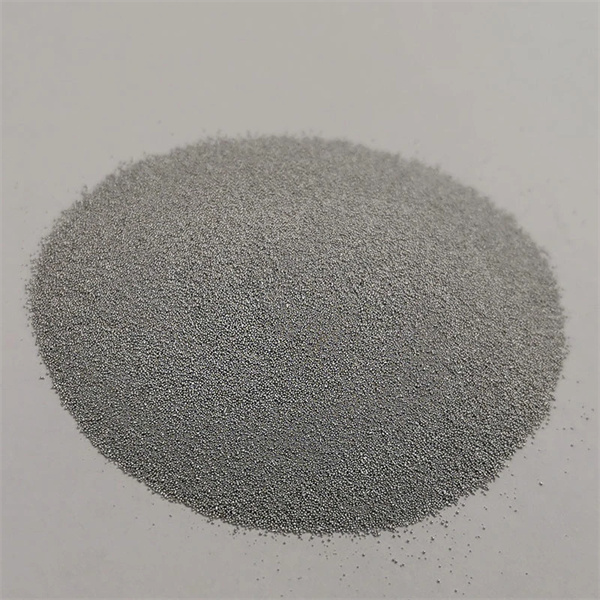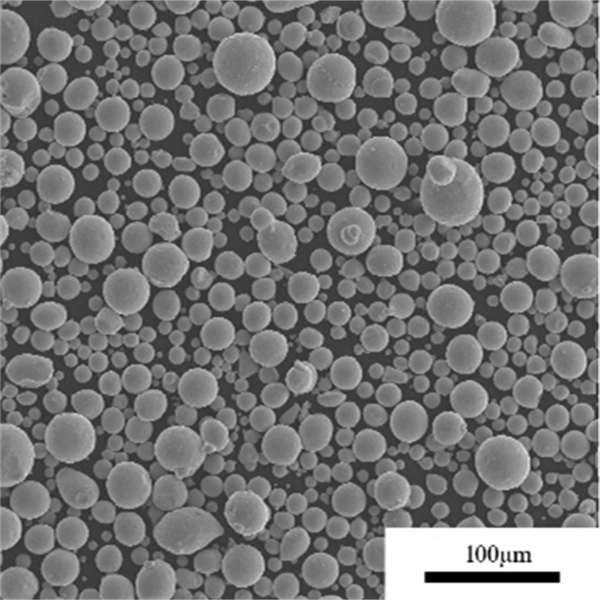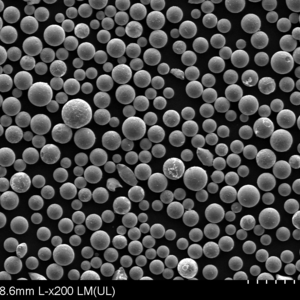Bột M2
M2 là một loại bột thép tốc độ cao được đặc trưng bởi độ cứng cao và khả năng chống mài mòn của nó cùng với độ bền tốt và cường độ nén. Nó được sử dụng rộng rãi trong sản xuất phụ gia kim loại để sản xuất dụng cụ bền để cắt, hình thành và dập các ứng dụng.
MOQ thấp
Cung cấp số lượng đơn hàng tối thiểu thấp để đáp ứng các nhu cầu khác nhau.
OEM & ODM
Cung cấp các sản phẩm tùy chỉnh và dịch vụ thiết kế để đáp ứng nhu cầu độc đáo của khách hàng.
Cổ phiếu đầy đủ
Đảm bảo xử lý đơn hàng nhanh và cung cấp dịch vụ đáng tin cậy và hiệu quả.
Sự hài lòng của khách hàng
Cung cấp các sản phẩm chất lượng cao với sự hài lòng của khách hàng tại cốt lõi.
Chia sẻ sản phẩm này
Mục lục
M2 là một loại bột thép tốc độ cao được đặc trưng bởi độ cứng cao và khả năng chống mài mòn của nó cùng với độ bền tốt và cường độ nén. Nó được sử dụng rộng rãi trong sản xuất phụ gia kim loại để sản xuất dụng cụ bền để cắt, hình thành và dập các ứng dụng.
Composition of M2 Powder
The composition of M2 high-speed steel powder is:
| Yếu tố | Cân nặng % | Mục đích |
|---|---|---|
| Vonfram | 6.0 – 6.8 | Hardness, wear resistance |
| Molypden | 4.8 – 5.5 | Toughness, strength |
| Crom | 3.8 – 4.5 | Khả năng cứng, Kháng mặc |
| Vanadi | 1.9 – 2.2 | Khả năng cứng, Kháng mặc |
| Carbon | 0.78 – 0.88 | Hardening |
| Mangan | 0.15 – 0.45 | Hardening |
| Silicon | 0.15 – 0.45 | Desoxidizer |
The high tungsten, molybdenum and chromium content impart excellent hardness and wear resistance.
Properties of M2 Powder
Key properties of M2 powder include:
| Tài sản | Sự miêu tả |
|---|---|
| Độ cứng | 64 – 66 HRC when heat treated |
| Hao mòn điện trở | Excellent abrasion and erosion resistance |
| Độ dẻo dai | Higher than tungsten carbide grades |
| Cường độ nén | Up to 300 ksi |
| Điện trở nhiệt | Can be used up to 600°C |
| Chống ăn mòn | Better than plain carbon steels |
The properties make M2 suitable for durable cutting, stamping and forming tooling.
AM Process Parameters for M2 Powder
Typical parameters for printing M2 powder include:
| Tham số | Giá trị điển hình | Mục đích |
|---|---|---|
| Chiều cao lớp | 20-50 m | Độ phân giải so với tốc độ xây dựng |
| Năng lượng laser | 250-500 W. | Đủ tan chảy mà không bị bay hơi |
| Tốc độ quét | 400-1200 mm/s | Mật độ so với tỷ lệ sản xuất |
| Khoảng cách nở | 80-120 m | Tính chất cơ học |
| Hỗ trợ cấu trúc hạ tầng | Tối thiểu | Dễ dàng loại bỏ |
| Nóng isostatic nhấn | 1160°C, 100 MPa, 3 hrs | Loại bỏ độ xốp |
Các thông số phù hợp với mật độ, cấu trúc vi mô, tốc độ xây dựng và các yêu cầu sau xử lý.
Applications of 3D Printed M2 Tooling
AM fabricated M2 components are used for:
| Ngành công nghiệp | Tooling applications |
|---|---|
| Ô tô | Stamping dies, forming tools, fixtures |
| Không gian vũ trụ | Jigs, fixtures, trim tools |
| Appliances | Punches, blanking dies, bending dies |
| Hàng tiêu dùng | Injection molds, stamping dies |
| Thuộc về y học | Cutting tools, rasps, drill guides |
Benefits over traditionally processed M2 tooling include complexity, lead time and cost reduction.
Specifications of M2 Powder for AM
M2 powder must meet strict specifications:
| Tham số | Sự chỉ rõ |
|---|---|
| Phạm vi kích thước hạt | 15-45 mm điển hình |
| Hình dạng hạt | Hình thái hình cầu |
| Mật độ rõ ràng | & gt; 4 g/cc |
| Chạm vào mật độ | & gt; 6 g/cc |
| Tốc độ lưu lượng hội trường | & gt; 23 giây cho 50 g |
| Sự thuần khiết | & gt; 99,9% |
| Hàm lượng oxy | & lt; 300 ppm |
Phân phối kích thước tùy chỉnh và độ ẩm kiểm soát có sẵn.
Suppliers of M2 Powder
Reputable M2 powder suppliers include:
| Nhà cung cấp | Vị trí |
|---|---|
| Sandvik Osprey | Vương quốc Anh |
| Phụ gia thợ mộc | Hoa Kỳ |
| Erasteel | Thụy Điển |
| Höganäs | Thụy Điển |
| Công nghệ LPW | Vương quốc Anh |
Prices range from $50/kg to $120/kg based on quality and order volume.
Handling and Storage of M2 Powder
As a reactive material, careful M2 powder handling is essential:
- Store sealed containers away from moisture, sparks, ignition sources
- Sử dụng đệm khí trơ trong quá trình chuyển và lưu trữ
- Thiết bị mặt đất để tiêu tan điện tích tĩnh
- Avoid dust accumulation through extraction systems
- Follow applicable safety precautions
Kỹ thuật thích hợp đảm bảo điều kiện bột tối ưu.
Inspection and Testing of M2 Powder
Phương pháp kiểm tra chất lượng bao gồm:
| Phương pháp | Tham số được kiểm tra |
|---|---|
| Phân tích rây | Phân phối kích thước hạt |
| Hình ảnh SEM | Hình thái hạt |
| EDX | Hóa học và thành phần |
| Xrd | Các giai đoạn hiện tại |
| Pycnometry | Tỉ trọng |
| Tốc độ lưu lượng hội trường | Khả năng chảy bột |
Kiểm tra trên mỗi tiêu chuẩn ASTM xác minh chất lượng bột và tính nhất quán hàng loạt.
Comparing M2 to Alternative Tool Steel Powders
M2 compares to other tool steel alloys as:
| Hợp kim | Hao mòn điện trở | Độ dẻo dai | Trị giá | Ease of Processing |
|---|---|---|---|---|
| Gì | Xuất sắc | Tốt | Trung bình | Hội chợ |
| H13 | Tốt | Xuất sắc | Thấp | Xuất sắc |
| Chính xác | Xuất sắc | Hội chợ | Cao | Khó |
| 420 stainless | Nghèo | Xuất sắc | Thấp | Xuất sắc |
With its balanced properties, M2 supersedes alternatives for many wear-resistant tooling applications.
Pros and Cons of M2 Powder for Metal AM
| Ưu điểm | Nhược điểm |
|---|---|
| Độ cứng tuyệt vời và khả năng chống mài mòn | Lower toughness than cold work tool steels |
| Good heat resistance and thermal stability | Yêu cầu xử lý sau khi điều trị bằng hông và nhiệt |
| Established credentials for metal AM | Controlled atmosphere storage required |
| Cost advantage over exotic tool steels | Khó khăn để máy sau khi in |
| Properties match conventional M2 | Limited corrosion resistance |
M2 enables high wear resistance additive tooling, though not suitable for highly corrosive environments.
Frequently Asked Questions about M2 Powder
Q: What particle size range works best for printing M2 powder?
A: Một phạm vi điển hình là 15-45 micron. Nó cung cấp khả năng chảy bột tối ưu kết hợp với các bộ phận có độ phân giải cao và dày đặc.
Q: What post-processing methods are used for M2 AM parts?
A: Hot isostatic pressing, heat treatment, surface grinding/EDM, and shot peening are typically used to eliminate voids, harden, and finish parts.
Q: Which metal 3D printing process is ideal for M2 alloy?
A: M2 can be effectively printed using selective laser melting (SLM), direct metal laser sintering (DMLS) and electron beam melting (EBM) processes.
Q: What accuracy and surface finish can be expected for M2 printed parts?
A: Post-processed M2 components can achieve dimensional tolerances and surface finish comparable to CNC machined M2 tooling.
Q: What industries use additively manufactured M2 tooling components?
A: Automotive, aerospace, medical, consumer goods, appliances, and industrial sectors benefit from 3D printed M2 tooling.
Q: What is the key difference between M2 and M4 grades of high speed steel?
A: M4 has slightly lower vanadium and molybdenum content leading to a better combination of wear resistance and toughness compared to M2.
Q: Does M2 require support structures when 3D printing?
A: Minimal supports are recommended on overhangs and bridges to prevent deformation and allow easy removal after printing.
Q: What density can be expected with optimized M2 3D printed parts?
A: Density above 99% is achievable for M2 using ideal parameters tailored specifically for this alloy.
Q: What defects can occur when printing M2 powder?
A: Potential defects are cracking, distortion, porosity, incomplete fusion, and surface roughness. Most can be prevented through optimized parameters.
Q: Is HIP required for all M2 AM tooling components?
A: While highly recommended, HIP may not be absolutely necessary for non-critical tooling applications. Heat treatment alone may suffice.
Về met3dp
danh mục sản phẩm
HÀNG HOT
LIÊN HỆ CHÚNG TÔI
Bất kỳ câu hỏi? Gửi tin nhắn cho chúng tôi ngay! Chúng tôi sẽ phục vụ yêu cầu của bạn với cả một nhóm sau khi nhận được tin nhắn của bạn.

Nhà cung cấp hàng đầu các giải pháp sản xuất phụ gia có trụ sở tại Qingdao, Trung Quốc.
THÔNG TIN LIÊN LẠC
- Ping to City, S lạnh mùa đông, Trung Quốc
- [email protected]
- [email protected]
- +86 19116340731







